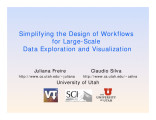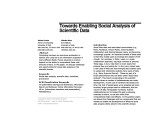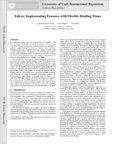1 - 25 of 25
| Creator | Title | Description | Subject | Date | ||
|---|---|---|---|---|---|---|
| 1 |  | Gopalakrishnan, Ganesh | An interface aware guided search method for error-trace justification in large protocols | Many complex concurrent protocols that cannot be formally verified due to state explosion can often be formally verified by initially creating a collection of abstractions (overapproximations), and subsequently refining the overapproximated protocol in response to spurious counterexample traces. ... | Concurrent protocols; Verification; Error-trace justification | 2008 |
| 2 |  | Freire, Juliana | Automatically extracting form labels | We describe a machine-learning-based approach for extracting attribute labels from Web form interfaces. Having these labels is a requirement for several techniques that attempt to retrieve and integrate data that reside in online databases and that are hidden behind form interfaces, including schema... | Learning classifiers | 2008 |
| 3 |  | Davis, Al | Automating the design of embedded domain specific accelerators | Domain specific architecture (DSA) design currently involves a lengthy process that requires significant designer knowledge, experience, and time in arriving at a suitable code generator and architecture for the target application suite. Given the stringent time to market constraints and the dyna... | Domain specific architecture; Stall cycle analysis; SCA; Domain specific accelerators | 2008 |
| 4 |  | Carter, John | Ensuring prolonged participation and deterring cheating behaviors in a collective | We are building a system that harnesses the idle resources (cpu, storage, and bandwidth) of nodes (e.g., home desktops) distributed across the Internet to build useful distributed services like content distribution or remote backup. Users are compensated in return for contributing their nodes? id... | Collective systems; Cheating; Idle resources; Nodes | 2008 |
| 5 |  | Gopalakrishnan, Ganesh | Inspect: a runtime model checker for multithreaded C programs | We present Inspect, a runtime model checker for revealing concurrency bugs in multithreaded C programs. Inspect instruments a given program at all global interaction points, and with the help of a new scheduler, examines all relevant thread interleavings under dynamic partial order reduction (DPO... | Multithreaded C programs; Model checker; Inspect; Concurrency bugs | 2008 |
| 6 |  | Kirby, Robert Michael II | Investigation of smoothness-increasing accuracy-conserving filters for improving streamline integration through discontinuous fields | Streamline integration of fields produced by computational fluid mechanics simulations is a commonly used tool for the investigation and analysis of fluid flow phenomena. Integration is often accomplished through the application of ordinary differential equation (ODE) integrators - integrators whose... | Streamline integration; Finite element; Finite volume; Filtering techniques; Adaptive error control | 2008 |
| 7 |  | Riloff, Ellen M. | Learning to identify reduced passive verb phrases with a shallow parser | Our research is motivated by the observation that NLP systems frequently mislabel passive voice verb phrases as being in the active voice when there is no auxiliary verb (e.g., "The man arrested had a long record"). These errors directly impact thematic role recognition and NLP applications that dep... | Passive voice; Reduced passive verb phrases; Shallow parser; Learned classifier | 2008 |
| 8 |  | Henderson, Thomas C. | Pattern formation in wireless sensor networks | Biological systems exhibit an amazing array of distributed sensor/actuator systems, and the exploitation of principles and practices found in nature will lead to more effective artificial systems. The retina is an example of a highly tuned sensing organ, and the human skin is comprised of a set o... | Pattern formation; Wireless sensor networks | 2008 |
| 9 |  | Balasubramonian, Rajeev | Scalable, reliable, power-efficient communication for hardware transactional memory | In a hardware transactional memory system with lazy versioning and lazy conflict detection, the process of transaction commit can emerge as a bottleneck. This is especially true for a large-scale distributed memory system where multiple transactions may attempt to commit simultaneously and co-ordin... | Hardware; Transactional memory; Communication | 2008 |
| 10 |  | Riloff, Ellen M. | Semantic class learning from the web with hyponym pattern linkage graphs | We present a novel approach to weakly supervised semantic class learning from the web, using a single powerful hyponym pattern combined with graph structures, which capture two properties associated with pattern-based extractions: popularity and productivity. Intuitively, a candidate is popular if ... | Weakly supervised; Semantic class learning; Hyponym pattern; Pattern-based extractions; Class name; Seed instance | 2008 |
| 11 |  | Freire, Juliana; Silva, Claudio T. | Simplifying the design of workflows for large-scale data exploration and visualization | Workflows and Computational Processes. Workflows are emerging as a paradigm for representing and managing complex computations - Simulations, data analysis, visualization, data integration. | 2008 | |
| 12 |  | Freire, Juliana; Silva, Claudio T. | Towards enabling social analysis of scientific data | Flickr, Facebook, Yahoo! Pipes), which facilitate collaboration and sharing between users, are becoming increasingly popular. An important benefit of these sites is that they enable users to leverage the wisdom of the crowds. For example, in Flickr, users, in a mass collaboration approach, tag ... | Social data analysis; Scientific data; Workflows; Provenance; Pipelines; VisTrails | 2008 |
| 13 |  | Shirley, Peter S.; Parker, Steven G. | Towards interactive global illumination effects via sequential Monte Carlo adaptation | This paper presents a novel method that effectively combines both control variates and importance sampling in a sequential Monte Carlo context while handling general single-bounce global illumination effects. The radiance estimates computed during the rendering process are cached in an adaptive per... | Ray tracing; Illumination; Monte Carlo methods | 2008 |
| 14 |  | Whitaker, Ross T. | Vispack | VISPACK (volume-image-surface package) is a C++ library that includes matrix, image, and volume objects and tools for manipulating level-set surface models | VISPACK; volume-image-surface package; C++ library | 2008 |
| 15 |  | Balasubramonian, Rajeev | Architecting efficient interconnects for large caches with CACTI 6.0 | Efficiently executing multithreaded applications on future multicores will require fast intercore communication. Most of this communication happens via reads and writes to large shared caches in the memory hierarchy. Microprocessor performance and power will be strongly influenced by the long inter... | Interconnects; CACTI 6.0; Non-uniform cache architectures (NUCA) | 2008-01 |
| 16 |  | Freire, Juliana; Silva, Claudio T. | End-to-end eScience: integrating workflow, query, visualization, and provenance at an ocean observatory | Data analysis tasks at an Ocean Observatory require integrative and and domain-specialized use of database, workflow, visualization systems. We describe a platform to support these tasks developed as part of the cyberinfrastructure at the NSF Science and Technology Center for Coastal Margin Obser... | Coastal margins; Ocean observatories; Workflow systems; VisTrails | 2008-12 |
| 17 |  | Hansen, Charles D. | Flow charts: visualization of vector fields on arbitrary surfaces | We introduce a novel flow visualization method called Flow Charts, which uses a texture atlas approach for the visualization of flows defined over curved surfaces. In this scheme, the surface and its associated flow are segmented into overlapping patches, which are then parameterized and packed in ... | 2008-09 | |
| 18 |  | Parker, Steven G. | Practical global illumination for interactive particle visualization | Particle-based simulation methods are used to model a wide range of complex phenomena and to solve time-dependent problems of various scales. Effective visualizations of the resulting state will communicate subtle changes in the three-dimensional structure, spatial organization, and qualitative tren... | Interactive particle visualization; Global illumination; Ray tracing; Luminance textures | 2008-02 |
| 19 |  | Freire, Juliana; Silva, Claudio T. | Provenance for computational tasks: a survey | The problem of systematically capturing and managing provenance for computational tasks has recently received significant attention because of its relevance to a wide range of domains and applications. The authors give an overview of important concepts related to provenance management, so that poten... | Provenance management; Computational tasks | 2008-05 |
| 20 |  | Freire, Juliana; Silva, Claudio T. | Scientific exploration in the era of ocean observatories | Society's critical and urgent need to better understand the world's oceans is amply documented and has led to a unique convergence of operational and scientific interests in the US, organized around the concept of ocean observatories: cyber-facilitated integrations of observations, simulations, a... | Ocean observatories; Provenance | 2008-05 |
| 21 |  | Freire, Juliana; Silva, Claudio T. | VisComplete: automating suggestions for visualization pipelines | Building visualization and analysis pipelines is a large hurdle in the adoption of visualization and workflow systems by domain scientists. In this paper, we propose techniques to help users construct pipelines by consensus-automatically suggesting completions based on a database of previously creat... | VisComplete; Workflows; Auto completion; Visualization pipelines | 2008-11 |
| 22 |  | Regehr, John | Edicts: implementing features with flexible binding times | In a software product line, the binding time of a feature is the time at which one decides to include or exclude a feature from a product. Typical binding site implementations are intended to support a single binding time only, e.g., compile time or run time. Sometimes, however, a product line must... | 2008-01-01 | |
| 23 |  | Regehr, John | Poster abstract: TinyOS 2.1 adding threads and memory protection to tinyOS | The release of TinyOS 2.0 two years ago was motivated by the need for greater platform flexibility, improved robustness and reliability, and a move towards service oriented application development. Since this time, we have seen the community embrace these efforts and add support for additional hardw... | 2008-01-01 | |
| 24 |  | Regehr, John | Runtime verification for wireless sensor network applications | Wireless sensor networks are widely used to detect environment information that is not accessible by human. Developing such networks however requires low-level programming. The lack of sophisticated debugging tools for sensor networks makes it difficult to make the connection between a high-level fu... | 2008-01-01 | |
| 25 |  | Regehr, John | Volatiles are miscompiled, and what to do about it | C's volatile qualifier is intended to provide a reliable link between operations at the source-code level and operations at the memory-system level. We tested thirteen production-quality C compilers and, for each, found situations in which the compiler generated incorrect code for accessing volatile... | 2008-01-01 |
1 - 25 of 25
